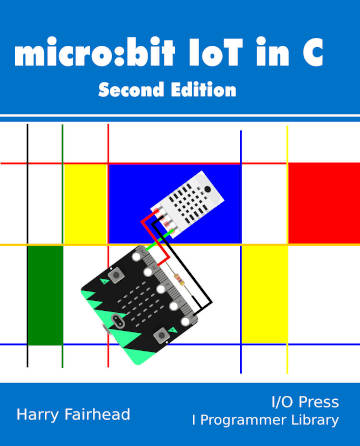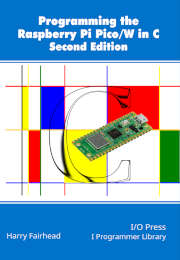Micro:bit IoT in C Second Edition
First Edition - Micro:bit IoT in C Notes and Errata
Errata: none
Resources
Micro:bit Programs

ISBN: 978-1871962673
Buy from: Amazon
The BBC micro:bit is capable of taking on a variety of roles including that of a powerful IoT device. In order to gain full access to its features and to external devices, however, you need to use C which delivers the speed which is crucial when you are writing programs to communicate with the outside world.
The new V2 version of the micro:bit is fully covered in Micro:bit IoT in C, Second Edition, which now uses the highly popular VS Code for offline development. It covers how to get started the easy way by providing downloadable templates for both V1 and V2 of the micro:bit.
Having started with the traditional "Blinky" program, the equivalent of "Hello World" for hardware, we are ready to discover how to control the micro:bit’s I/O lines, exploring the basis of using the GPIO. For speed, however, we need to work directly with the raw hardware and also master memory mapping, pulse width modulation and other more sophisticated bus types. From here we can start connecting sensors using first the I2C bus, then by implementing a custom protocol for a one-wire bus, and eventually adding eight channels of 12-bit A-to-D with the SPI bus, which involves overcoming some subtle difficulties. We then look at serial connections, one of the oldest ways of connecting devices, but still very useful. The micro:bit lacks WiFi connectivity but using a low-cost device we enable a connection to the Internet via its serial port which allows it to become a server. Next we look at the micro:bit’s LED display. This may only be 5x5, but it is very versatile, especially when you use pulse width modulation to vary the brightness level, something we demonstrate in a classic game, written of course in C. The book rounds out with a new chapter on the micro:bit’s radio and the V2’s sound capabilities.
Harry Fairhead has worked with microprocessors, and electronics in general, for many years and is an enthusiastic proponent of the IoT. He is the author of Raspberry Pi IoT in C, which has recently been republished in its second edition, updated for Raspberry Pi 4, and of Raspberry Pi IoT In C With Linux Drivers. He has also co-authored Python versions of these books - Raspberry Pi IoT in Python Using GPIO Zero and Raspberry Pi IoT In Python With Linux Drivers. His own language of choice is C and he has also written Fundamental C: Getting Closer To The Machine and Applying C For The IoT With Linux.
- Language : English
- Paperback : 267 pages
- ISBN-10 : 1871962676
- ISBN-13 : 978-1871962673
- Item Weight : 1.3 pounds
- Dimensions : 7.5 x 0.61 x 9.25 inches


